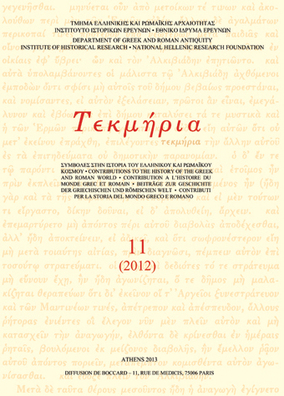Ἡ ἑβραϊκὴ κοινότητα τῆς Βέροιας στὴν Ἀρχαιότητα : Νέες ἐπιτύμβιες ἐπιγραφές
Part of : Τεκμήρια ; Vol.4, 1998, pages 13-30
Issue:
Pages:
13-30
Parallel Title:
The Jewish community of Beroia in the ancient period : New grave inscriptions
Section Title:
Articles
Author:
Abstract:
Four new grave inscriptions from Beroia furnish interesting information about the members and the organisation of the city's Jewish community in the ancient period. The existence of the community was already known from a passage in the Acts of the Apostles (17:10-15), as well as from two older grave monuments that had been found immured. Two of the new inscriptions came to light during a rescue excavation in a plot of land in the city, while the other two were picked up not far away from the excavation site. The first stele, from the grave of a Jew named Theodosios, refers to the deceased as mettopresbyteros, a term which appears here for the first time in a Jewish inscription and means one who has been elected to the office and is to serve the following year. The second stele preserves part of an inscription in verse, the second example from Greece, referring to a hymnodist of the community and extolling his exceptional abilities, if we have correctly understood the expression used. This is the first and only evidence from Greece of the singing of psalms in the synagogues of the Diaspora, and shows that, in terms of ritual, the Beroia community in no way lagged behind the large Jewish communities of Rome and Aphrodisias, which are the sources of the other two documents we possess. The third stele is decorated with Hebrew symbols and unfortunately preserves very few letters from the inscription. The fourth item is an inscribed colonnette commemorating the dead Ioustenos. Unfortunately, the inscriptions can be dated only by the uncertain criterion of the shape of the letters and the general impression of the script, for the excavation data offer no chronological support. The first two inscriptions may be dated to the first half of the fourth century AD and the third and fourth to the second half of the same century. Apart from their importance for the history of the local community, the new epigraphical finds are also of more general interest with regard to the organisation and the religious and social life of the other communities of the Diaspora too. The existence, ascertained for the first time here, of an elected body of elders in the Beroia community may serve as a parallel not only for the other communities in Greece, but also for those in the rest of the Diaspora, and confirms the opinion of many scholars that the organisation of the Jewish communities must have been influenced by that of the numerous (professional and religious) associations that appears all over the Roman Empire. It is significant that, while the two earlier stelai were found re-used and immured, two of the new inscriptions came to light in the course of excavations. The fact that the other two were picked up nearby strengthens our hypothesis that this was the site of the Jewish cemetery. If this is indeed so, then the rest of the finds from the area indicate that the Jews were buried near the Christians and the pagans, which is gradually being shown to have been the case with most of the communities of the Diaspora. We believe that although the burial of Jews in the same place as the others does not prove that relations between them were cordial, it does at least show that there was no active hostility. The Jews' considerable degree of integration into their environment, which the new data reveal to have been the case in most communities, never went as far as assimilation. The Jews always preserved their strong ethnic and religious consciousness, proudly declaring their ethnic and religious identity on their burial monuments and associating themselves first and foremost with the synagogue, which was a fundamental reference point in the Diaspora.
Subject:
Subject (LC):




